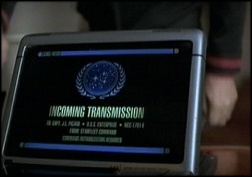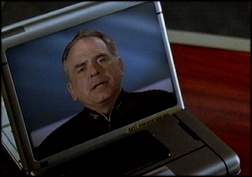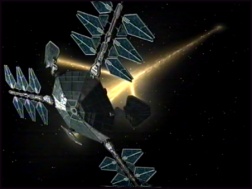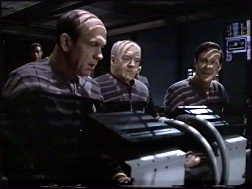
|
Physics |
Overview
This chapter tries to explain several
physical problems of Star Trek regarding the real science as well as fictitious fields like
"subspace physics". It has to be clarified:
Why interstellar
real time communication is impossible
 |
 |
Problem: Communication belongs to the everyday scenes in all
Star Trek series and feature films - using of the intercom to contact other crew members,
touching the commbadge in an away team to hail the ship in the orbit, and also the
application of the more powerful communication systems of a starship to call the ground
station on a planet, other vessels or Starfleet Command (like in the above picture). Since
basically, communication via radio, as it is nowadays used for space travel, is restricted
to light speed (i.e. 299 792 km/s), with
present technical means the latter case - communication bridging interstellar distances -
would not be possible. Therefore, already in the original Star Trek series subspace radio
was introduced to avoid this problem, since this fictional technology transmits signals
much faster than normal sublight radio, how [TOS] The Cage and [TOS] A Piece of Action
showed. Subspace radio, which transmits the conventional electromagnetic waves to
subspace, seemed to be so fast that a time lag only occurred with a two-way communication
over long distances ([TOS] Balance of Terror). In the later series and movies, again
mostly real time communication was used. Unfortunately, the official technical explanation
of subspace communication in the official documentations at the beginning of the 1990s
caused more problems than it solved: just as the multiples of light speed for the warp
factors of starships, given in the ST:TNG Technical Manual for the first time, appeared
much to small with regard to the and the general size of the Federation and the immense
distances often bridged within one episode, the warp
9.9999 / 199 516c mentioned in the Star Trek Encyclopedia are too small values
to allow an interstellar communication without time lag. A simple calculation shows that
with these values (which are only valid for subspace radio boosted for example by relay
stations), already for a bridged distance of one light year a notable lag occurs. To
calculate the transmission time, that means to duration of a single signal transmission,
we take the basic physical equation for velocity V=s/t. More interesting regarding two-way communication, however, is
the response time, i.e. the time it takes to get an answer after the transmission of our
signal. Since therefore, the signal has to bridge the double distance, the corresponding
equation is V=2s/t. Putting both equations to t, we get the following numbers for various
distance of transmitter/receiver 1 to transmitter/receiver 2:
| Distance |
Transmission time |
Response time |
0.5 AE
(Earth-Mars) |
1.25 ms |
2.5 ms |
4.2 AE
(Earth-Jupiter) |
10.5 ms |
21 ms |
| 1 ly |
2 min 38 s |
5 min 16 s |
4.4 ly
(Earth-Alpha Centauri) |
11 min 35 s |
23 min 10 s |
16.45 ly
(Earth-Vulcan) |
43 min 20 s |
1 h 26 min 40 s |
app. 120 ly
(DS9-Earth) |
5 h 16 min 8 s |
10 h 32 min 16 s |
Since the median star distance in the
Milky Way is 1 pc (3.26 ly), real time communication via subspace radio is merely possible
within one planetary system. Unfortunately, despite this restriction all the other cases
have been shown on screen, and after the first seasons of Star Trek: Deep Space Nine at
least avoided a direct contact DS9-Earth in favor of near starbases etc., in some later
episodes even the absolute impossible was suddenly possible: real time communication over
a distance of more than a hundred light years! To make things worse, the ST:DS9 TM
suggests that 90% of the existing subspace relais network of the Federation has been
destroyed or dismantled since 2371. Consequently, the maximum (boosted) subspace radio
speed can't be reached any more, and in view of the distance limit of 22.65 for this
velocity, the increasing signal scattering and decay without refocussion and
repolarization or the generally unsteady nature of subspace it is questionable anyway if a
signal transmitted over such a long distance without intermediate relays would ever reach
Earth.
Reasons: Just as many other inconsistencies and errors of Star Trek,
the problem with the impossible, but nevertheless frequently shown interstellar real time
communication is caused by the formula "simplicity overrules correctness". Of
course, it would be considerably more laborious to use one-way messages the most time.
Moreover, admittedly an important dramatic element would be lost: the frequent real time
communication expresses quasi an interstellar connection between the planets or
between a ship and its home base, respectively - a "sense of belonging". That is
why the more correct communication with time lag is only used when it is intended to show
that there is a great distance to home or the ship is "separated from known
universe", e.g. in [TOS] Balance of Terror, [TNG] Where No One Has Gone Before or
[TNG] The Defector.
Explanation: A solution of the problem is extremely difficult. While there
are two - equally radical - possibilities for the problem with the too low warp speeds
regarding the distances of the planets (the equivalent speeds are wrong, i.e. warp is
considerably faster, or the planets are all located in a smaller volume of space), here
only the explanation remains that the subspace radio speed of warp 9.9999 / 199
516c has to be wrong, since logically not all planets can
be situated in the same system. Because this figure was only mentioned in a single
official documentation (Star Trek Encyclopedia, while the technical manuals give warp
9.9997 as a contradicting speed limit) and never confirmed on screen, it wouldn't be a
problem to increase the speed - if this procedure would not influence all those cases in
which communication was intentionally prevented. For instance, if subspace radio would be
one hundred times faster, at least contact between adjacent planetary systems would be
possible. On the other hand, the deliberate communication time lags e.g. from the Romulan
Neutral Zone to Earth wouldn't make sense any more. Also, in the sixth year of her journey
(distance: app. 30000 ly) the USS Voyager could contact Starfleet Headquarters with a
response time of only 24h, if such a ultra long range communication wouldn't be impossible
due to the nature of subspace itself (see next problem). Because of this dilemma, there
isn't any plausible explanation for the problem, and just as the sound effects in space,
we can only accept it as a dramatic means to an end.
Why Voyager could
not contact Earth up to now
 |
 |
Problem: Since Voyager has been stranded in the farthest edge
of the Delta Quadrant in 2371, the starship has been cut off from Federation that was
75000 ly away in the beginning, since even subspace radio has a response delay of several
years for this incredible distance. Although Voyager has shortened the distance by half
within 5 years, successful contacts with the Alpha Quadrant remained short, unique events.
They were based on natural phenomena or alien technology: in [VOY] Eye of a Needle a micro
wormhole is used to communicate with a Romulan science ship in the Alpha Quadrant, but the
crew does not succeed in calling Starfleet before [VOY] Message of a Bottle, in the forth
year of Voyager's journey, where finally contact is established by an ancient,
transgalactic relais network. The sixth year, particularly the episode [VOY] Pathfinder,
is a turning point of the voyage: Starfleet itself succeeds in opening a micro wormhole
with the help of the MIDAS array and a itinerant pulsar in order to contact Voyager, with
the prospect for a more regular communication (see pictures). At 32 day intervals, this
perspective becomes possible as of [VOY] Life Line, again thanks to the MIDAS array which
amplifies subspace signals with the aid of a cyclic pulsar this time. However, the
question arises why such ponderous and difficult ways of communication are necessary at
all - after all, according to the Star Trek Encyclopedia the (maximum boosted) subspace
radio speed is warp 9.9997 / 199 516c, so that in the sixth year of the journey, in which
Voyager is about 30000 ly away from Earth, a subspace signal should only travel 54 days to
Earth.
Explanation: In this case, the problem is not caused by a mistake of the
authors or "dramatic intention", but is because of the technical limitations of
subspace radio and the nature of subspace, which there never mentioned on screen, but in
the ST:TM and ST:DS9 technical manuals. Basically, we know that every kind of signal -
even highly-focused EM waves like laser beams - scatter when transmitted over extreme
distances. If this applies to subspace radio as well, this means that even a
highly-focused and radially polarized subspace signal, directed to Earth, will become a
very weak, broadband signal over this distance, if it is not repeatedly refocused
and redirected. To make things worse, one property of subspace itself affects the signal,
making long range communications impossible. the signals transmitted (or
"forced") to subspace tend to make their way back to the "surface"
after a certain distance and finally to reemerge from subspace, becoming a slower and also
decayed EM signal again. The distance depends on the subspace layer to which the signal
was transmitted. Higher energies of the initial signal correspond to a deeper transmission
layer of subspace, a higher transmission speed and also a longer maximum distance. The
ST:DS9 TM clarifies that even in the 2370s, the technical limit still remains at
warp 9.9997 and 22.65 light years. Therefore, transgalactic subspace communication with
acceptable transmission delays is impossible with contemporary technologies, a standard
subspace signal transmitted by Voyager would never reach the far away Earth. Two
possibilities remain: either the signal is regularly amplified and refocused (like the now
destroyed alien relay network from [VOY] Message in a Bottle did), or the initial signal
itself must have an unbelievable energy (e.g. by amplifying the transmitted peak energy
with the aid of a pulsar, like in [VOY] Life Line). Due to the existing proportionality,
the signal would then be shifted to a transmission layer deeper in subspace, the maximum
distance would be lengthened and the signal would be more resistant to subspace
distortions etc. However, it appears odd with the latter possibility, that Voyager
seemingly can answer (for 17 hours), although evidently these immense energies for the
amplification of signals aren't at the crew's disposal. This inconsistency may only be
explained with Seven of Nine's Borg abilities, the experiences with trans-dimensional
manipulation via main deflector in [VOY] Scorpion II and [VOY] Prey or probably the
allusions from [VOY] Pathfinder concerning "modifications of the comm system for
signal transmission at hyper-subspace speeds".
|